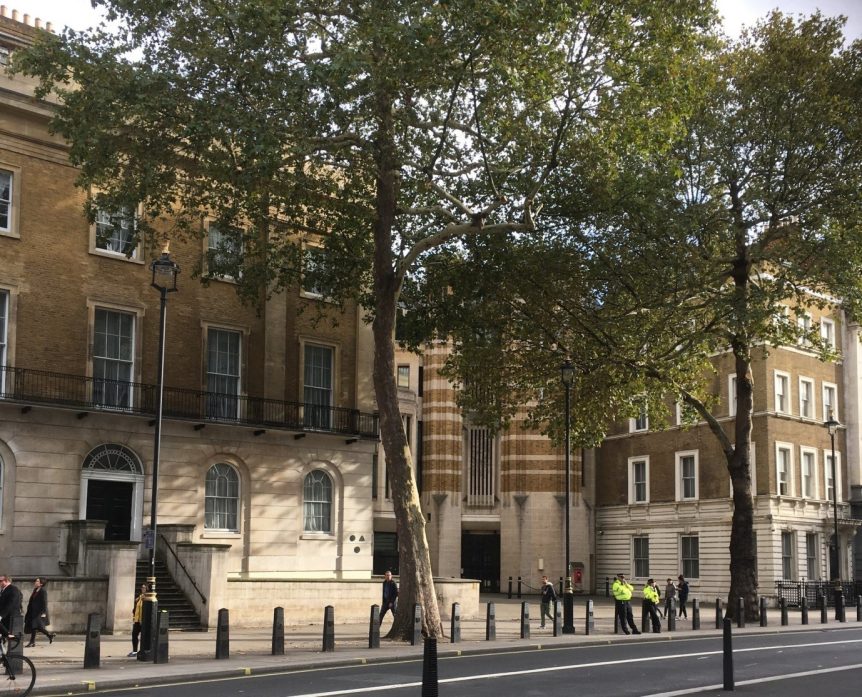We encourage Georgian Group members to support the campaign to prevent the demolition of a large part of Richmond House, the Grade II* government offices in Westminster designed by Whitfield Associates between 1982-4.
The building responds in an intelligent way to its context, which on two sides is Georgian and later 19th century in date – indeed on its northern flank it incorporates the remaining fabric of Richmond Terrace (1822-24). Its dramatic Neo-Tudor entrance to Whitehall, directly opposite Edwin Lutyens’s Cenotaph but deferentially recessed from the street frontage, is framed to the north by the eastern angle pavilion of Richmond terrace and to the south by the mid-18th century house at no. 85. Richmond House itself is exemplary in its massing, in the quality and use of its materials, and in its detailing. On its completion the architect and critic Roderick Gradige suggested that it marked ‘the beginning of a new architecture.’
Why is Richmond House under threat?
In January of this year the House of Commons voted to relocate to Richmond House in 2025 for an estimated six years to allow for the planned restoration of the Place of Westminster, variously projected to cost between £3.5bn and £5.7bn; the House of Lords may relocate to the Queen Elizabeth II Conference Centre. A 2016-17 report on the Restoration and Renewal of the Palace of Westminster issued by the House of Lords House of Commons Joint Committee suggested that ’If Richmond House were to be acquired a temporary Chamber could be established in its inner courtyard.’ It emerged earlier this month, however, that the works to accommodate the Commons, proposed by Alford Hall Monaghan Morris, would now see most of Sir William Whitfield’s and Andrew Lockwood’s building demolished. The building of a third, permanent chamber is a dramatic departure from the joint committee’s proposal that a temporary chamber could be provided in the inner courtyard of Richmond House. In the proposed scheme, only the grand palace-fronted façade provided by Richmond Terrace and the entrance façade on Whitehall (see photo) would survive. It is ironic that a major building designed less than 40 years ago is in danger of becoming a victim of façadism. Richmond Terrace, designed by Thomas Chawner (1774-1851), one of Sir John Soane’s pupils, and built by George and Henry Harrison, suffered this fate in the late 1970s.
A viable, lower-cost alternative has been proposed by Sir Michael Hopkins. This would see a temporary Commons debating chamber inserted into the courtyard atrium of his award-winning building Portcullis House (1998-2001) on Bridge Street.
Richmond House is listed Grade II* in recognition of the qualities outlined above. Demolition flies in the face of the statutory system of protection afforded to outstanding buildings.
Demolition flies in the face of the statutory system of protection afforded to outstanding buildings.
Richmond House was built at tax-payers’ expense. Is the great cost of the proposed demolition and rebuilding justifiable? A Treasury select committee has rightly scrutinised the cost of the restoration works to the Palace of Westminster, but are the costs of the proposed damaging works to Richmond House to undergo similar scrutiny?
The energy embedded in Richmond House during its construction – the sum of the energy expended in the extraction of raw materials, transport, manufacture, assembly and installation – is enormous and will be wasted if demolition proceeds. Does doing so demonstrate national leadership in promoting environmental best-practice?
What impact might the introduction of the security measures necessary to convert Richmond House to parliamentary use have on the architectural dignity of Whitehall and the immediate setting of the Cenotaph?
Details of the campaign against the current proposals by SAVE Britain’s Heritage can be seen via the following link.
Sir William Whitfield’s work ranges from 1960s brutalism to neo-classicism. In 2004 he was awarded a Georgian Group architectural award (Best New Building in the Classical Tradition) for the design of Tusmore House, Oxfordshire. He has served too as a trustee of the Georgian Group
Share this Post


Comments 5
As the architect responsible for the detail design of all the brick and stone masonry at Richmond Terrace, I am shocked to learn about the proposed demolition of much of this building. William Whitfield was a genius designer and I was fortunate to work with him in my formative years to realise his concept for the building.
A couple of suggestions:
The pic above might be better as a full frontal of this beautiful building
How about a petition?
As the project architect and Associate in charge of Richmond House and involved from its inception in 1975 to its completion in 1987 I too share Richard Young’s shock at the possible loss of the building.
You describe the building as being by Whitfield and Lockwood. The architect was Whitfield Partners which practice comprised three partners viz. William Whitfield, David Lyle and Philip Sayer. I was one of four associates along with Andrew Lockwood, Andrew Mason and David Walsh. The partner in charge throughout was Philip Sayer.
Much of the elaboration and detail design was mine as anyone involved in the project will attest. We saw very little of the late Sir William Whitfield during the construction phase. I agree with Richard Young’s comment that Whitfield was an architectural genius. He placed great trust in his small office and I was glad to have served him on this and other projects.
What can be done to save these beautiful buildings?
They must be saved.
This is shocking, beyond anything one could imagine – a horrible reflection on our soulless “civilization” : I would not, could not believe this threat until I saw it in print. In massing, in texture – in every detail – it is entirely wonderful, and lifts the spirits whenever one catches sight of it, from any direction. It appears as an apparently effortless solution to a significant yet difficult site. It fulfils that paradoxical requirement of making an important statement, while remaining a good neighbour : well-mannered, and respectful of its environs.
How many buildings of quality and character do we, even in our great Capital, now possess – especially of our own time – buildings that already give evidence of “growing old gracefully” – that we can afford to dispense with such a glorious example as this? To destroy such grace and wit would be philistine indeed…Bring on that generous solution of using space in the Cloisters Building: that gets MY vote!